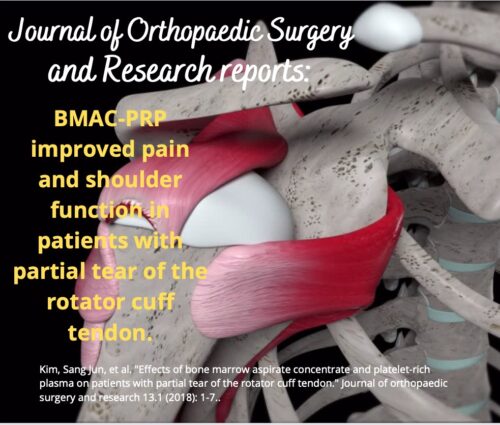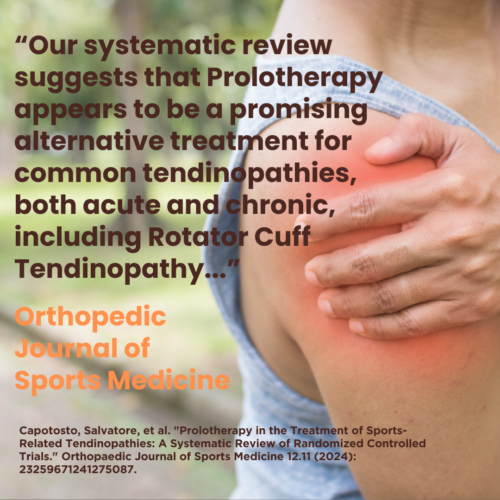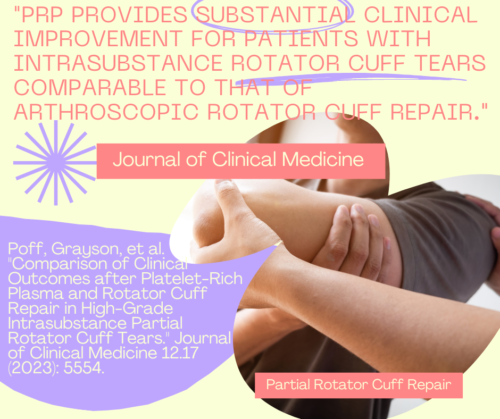
Have you been told you have a partial rotator cuff tear? Surgery may have also been recommended, but you would like to avoid that. So what else can you do? At OrthoRegen®, you have a non-surgical option.
We often see patients in our office trying to avoid surgery after diagnosing a partial rotator cuff tear. And we would like to help them accomplish their pain relief and restoration of function goals! Once we do a physical examination and take a medical history, we can assess which regenerative treatment will most effectively repair your shoulder from the damage sustained to the rotator cuff.
There are four muscles inside of the shoulder that allow us to rotate our arms. These four muscles form a cuff of tendons around the top of the arm or the humeral head. With a rotator cuff tear, one or more of the tendons of those four rotator cuff muscles of the shoulder are involved.
The rotator cuff is designed to move the shoulder joint. When there is a tear, the tendons are weakened and will degenerate, increasing their susceptibility to even more tears. Rotator cuff tears will create a cycle of instability in the shoulder and set it up for more damage if not treated.
When the rotator cuff is injured or becomes torn, structural problems occur and the entire shoulder can become unstable. Treatment for shoulder instability from tears and injury often involves rotator cuff strengthening exercises of the four muscles of the shoulder. Those muscles include the supraspinatus, infraspinatus, subscapularis, and teres minor, which help stabilize the shoulder and assist with movement.
Unfortunately, even though strengthening exercises help strengthen the shoulder muscles, they often do not resolve the underlying problem of shoulder instability. To fix shoulder joint instability, the shoulder tendons, ligaments, and shoulder capsular structures must all be strengthened. And that’s where Regenerative Orthopedics comes in!

Regenerative Orthopedics, like Prolotherapy, PRP, and Stem Cells, are excellent options for rotator cuff injuries because the treatments involve repairing and regenerating soft tissue. Plus, these non-surgical therapies offer repair with a short recovery time. That’s good to know since many can expect a wait of 8 months before returning to work after surgical repair. (1)
In six studies that examined the effectiveness of Prolotherapy on Rotator Cuff injuries, the majority of the studies showed superior improvement with Prolotherapy than the control. (2)
Regenerative Orthopedics addresses the root cause of the problem by repairing the tear and the instability as a first-line alternative to costly and invasive surgery. And that leads to a better recovery.
A February 2022 paper in the journal Orthopedic Research and Reviews (3) discussed the challenges of treating a partial rotator cuff tear.
They said: “Partial thickness tears of the rotator cuff are a common cause of shoulder pain and disability. Surgery is confined to those experiencing severe symptoms despite non-operative measures and for tears involving greater than 50% thickness. A number of surgical strategies have been described, but there is insufficient evidence to advocate one repair technique over another. . . ”
Sure, it’s possible to have successful shoulder surgery. But why choose surgery when there is an alternative that has a much shorter recovery period? We see many patients who are exploring alternatives to rotator cuff surgery because they would like to get back to work or a sport more quickly and would prefer to avoid the long post-surgical recovery time.
Regenerative Orthopedics is the non-surgical alternative that can offer repair without the prolonged recovery time of surgery. In many cases, Prolotherapy alone is effective at treating the injury.
PRP or Stem Cells may be recommended depending on the injury or degeneration involved. PRP and Stem Cells accelerate healing by using your own blood platelets and/or stem cells. These are always used in conjunction with Dextrose Prolotherapy to provide the most comprehensive treatment and repair.
The Orthopedic Research and Reviews journal reports, “Stem cell treatment for rotator cuff tears is a promising development because they have been shown to result in an anti-inflammatory response, improved tendon regeneration, optimized collagen fiber arrangement, higher load-to-failure, and higher tensile strength. . . In a non-randomized controlled trial comparing the effects of an exercise regime to PRP combined with bone marrow aspirate (BMAC-PRP complex) on partial rotator cuff tears, the experimental group demonstrated a significantly greater improvement in (pain, function and disability) scores compared to controls at three months. Tear size decreased after BMAC-PRP injection although this did not significantly differ from controls.”(3)
The Journal of Orthopaedic Surgery and Research found a positive benefit of a combined bone marrow aspirate concentrate (stem cell) and platelet-rich plasma (PRP) BMAC-PRP injection in patients with a partial tear of the rotator cuff tendon. (6)
Another group of researchers in the Journal of Shoulder and Elbow Surgery studying the effectiveness of PRP on rotator cuff lesions noted that the use of PRP “shows promise in shortening the treatment period and preventing the recurrence of rotator cuff lesions.” (7)

Platelet-rich plasma is an autologous blood product that contains numerous growth factors that promote healing by stimulating biological pathways to facilitate the natural healing process. Researchers compared PRP injections to arthroscopic rotator cuff repair and found that “PRP provided substantial clinical improvement for patients with intrasubstance rotator cuff tears comparable to that of arthroscopic rotator cuff repair.” They also noted that recovery time was much shorter with PRP! The research suggests that PRP could serve as an alternative treatment option to arthroscopic repair. (8)
The combination of repair with these regenerative treatments promises an excellent chance for full recovery and full performance. In the event that surgery is truly necessary, Regenerative Orthopedics is also an excellent post-operative treatment to improve tissue strength, stability, and overall recovery. This may be a possibility when a rotator cuff tear has become large enough to produce profound weakness in the shoulder.
Please contact us at OrthoRegen®, and tell us more about your case to determine if you are a good candidate for Comprehensive Regenerative Orthopedics.
1 Gowd AK, Cvetanovich GL, Liu JN, Nwachukwu BU, Cabarcas BC, Cole BJ, Forsythe B, Romeo AA, Verma NN. Preoperative Mental Health Scores and Achieving Patient Acceptable Symptom State Are Predictive of Return to Work After Arthroscopic Rotator Cuff Repair. Orthopaedic Journal of Sports Medicine. 2019 Oct 25;7(10):2325967119878415.
2 Capotosto, Salvatore, et al. “Prolotherapy in the Treatment of Sports-Related Tendinopathies: A Systematic Review of Randomized Controlled Trials.” Orthopaedic Journal of Sports Medicine 12.11 (2024): 23259671241275087.
3 Thangarajah T, Lo IK. Optimal Management of Partial Thickness Rotator Cuff Tears: Clinical Considerations and Practical Management. Orthopedic Research and Reviews. 2022;14:59.
4Yeo, Daniel YT, et al. “The relationship between intraoperative tear dimensions and postoperative pain in 1624 consecutive arthroscopic rotator cuff repairs.” The American Journal of Sports Medicine 45.4 (2017): 788-793.
5Rizvi SM, Lam P, Murrell GA. Repair Integrity in Patients Returning for an Unscheduled Visit After Arthroscopic Rotator Cuff Repair: Retorn or Not? Orthopaedic journal of sports medicine. 2018 May 29;6(6):2325967118775061.
6Kim SJ, Kim EK, Kim SJ. Effects of bone marrow aspirate concentrate and platelet-rich plasma on patients with partial tear of the rotator cuff tendon. Journal of orthopaedic surgery and research. 2018 Dec;13(1):1.
7Celikten, Mert, et al. “The effect of platelet-rich fibrin, platelet-rich plasma, and concentrated growth factor in the repair of full thickness rotator cuff tears.” Journal of Shoulder and Elbow Surgery 33.5 (2024): e261-e277.
8Poff, Grayson, et al. “Comparison of Clinical Outcomes after Platelet-Rich Plasma and Rotator Cuff Repair in High-Grade Intrasubstance Partial Rotator Cuff Tears.” Journal of Clinical Medicine 12.17 (2023): 5554.